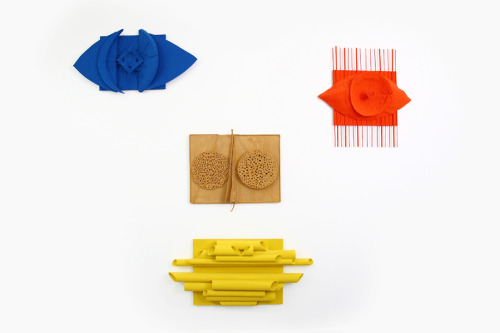Dikeou Superstars: Anya Kielar

Pareidolia is when the mind senses and reinterprets certain stimuli and reconfigures them into a recognizable form. An example of this is seeing familiar objects or lifeforms in cloud formations, or hearing speech patterns behind a veil of white noise. There is a strong psychological drive to personify that which is non-human, and it is one that has served as great creative inspiration for artists for centuries. Attuned to this phenomenon is Anya Kielar, whose assemblages of old shower heads, brooms, and egg cartons merge together to create Sand Face #1 and Sand Face #2. Exhibited at Dikeou Collection, the two works “face” one another on opposite walls, placing the viewer between their staring eyes made of rope and sticks and coated with boldly colored sparkling sand. The faces imbue inanimate objects with character and emotion, but they also look at moments in art history that mark significant shifts in cultural, aesthetic, and social values.
In a zingmagazine interview with Rachel Cole Dalamangas, Kielar expressed that she is “fascinated by ancient cultures and drawn to things that were made to carry out some symbolic purpose or that had some kind of belief structure behind them.” She instills these objects with energy and magic, transforming them from trampled waste into 21st-century totems. In her artist statement Kielar compares covering the objects with sand to entombment, in which “they become more like archaeological relics that are part of an eccentrically hewn alphabet. What they spell out is interchangeable and depends on how the viewer projects their own identity complex.” This mode of thought spills into the world of Surrealism, which found much inspiration from the archaeological and ethnographic artifacts coming from Africa, Central and South America, and Asia. The “projection” alluded to by Kielar can also be connected to the Surrealists’ interests in psychology and how the mind works on a subconscious level. Her process of picking up random objects off the street and collaging them together onto Masonite is akin to the Surrealist gesture of automatism.
Jump ahead several decades and we see how Sand Face #1 and Sand Face #2 fits perfectly within the 1970s-era of funky arts & crafts. Fiber arts were particularly popular during this era. From macramé plant holders and yarn-wrapped gods eyes, to embroidered wall hangings and crocheted halter tops, these homespun creations were crucial to the aesthetics of the 70s. Paint-by-number, colored gravel, pet rocks, beading, tie-dye, pressed and wax-dipped flowers were also prevalent. Characterized by a simple approach to design and forward use of color, it is easy to see how the creative hobby trends of the 1970s emanate from Kielar’s sand face creations.

Crafting is [stereotypically] characterized as a female activity, something that is done in the home with domestic materials, and feminist artists of the 70s employed crafts to communicate the limitations opposed on women as well as celebrate their power. One of the strongest examples of this was the Womanhouse project/exhibition organized by Miriam Schapiro and Judy Chicago in 1972 in California. Susan Frazier’s Aprons in the Kitchen, Faith Wilding’s Crocheted Environment, and Sandy Orgel’s Linen Closet showed how the female experience is defined by the space, objects, and expectations associated with the home in ways that are both positive and negative. Likewise, Kielar has used art as a way to explore the complex nature of femininity, both universally and personally. The female figures she depicts, or vestiges thereof, are sharp, uninhibited, and confident but also playful, humorous, and inviting. Sand Face #1 and Sand Face #2 are key examples of how multifaceted women’s lives are, and, like the pareidolia experience, it is something that can catch you off-guard but leave you feeling charmed.
-Hayley Richardson
